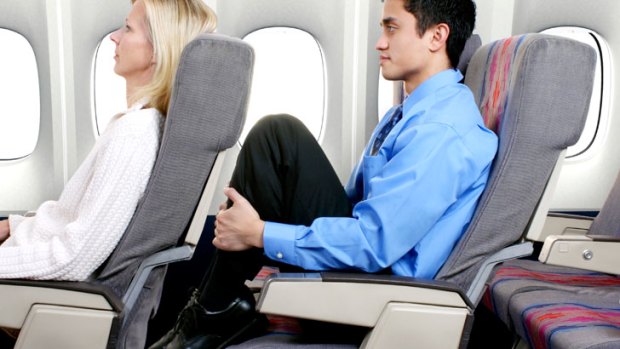
In-flight outbursts: Smaller plane seats and crowded flight are putting more stress on passengers.Credit: iStock
With airlines packing more people onto every plane, frustration among US air passengers is boiling into rage over nuisances as minor as a reclining seat-back taking some personal space.
Stress among fliers "is not going to go away any time soon, and the amount of traffic we're carrying contributes to that," said Audrey Stone, president of Transport Workers Union Local 556, which represents Southwest Airlines flight attendants.
An on-board outburst that forced a Delta Air Lines jet to make an unscheduled landing on September 1 this year, marked the third such case in a span of nine days in the US. As flight-crew members see it, the mix of peak vacation-season travel and fewer empty seats can produce a combustible outcome - and the safest course can be touching down to offload a belligerent traveller.
"The problem with people in the back who are fighting over tray tables, or fighting over cellphones or whatever, is it can escalate," said Denny Kelly, a Dallas-based aviation accident investigator and former Braniff International Airways pilot. "The last thing you want is a brawl in the back."
Even before the height of the US travel season, the industry was packing more people onto each plane. Airlines filled an average of 85 per cent of their seats in May, according to Transportation Department data. A decade earlier, the figure for May was 75 per cent.
"Every summer, with the load factor, you're obviously going to see some tension out there," said Tom Hoban, spokesman for the Allied Pilots Association at American Airlines Group, the world's biggest carrier. "It's a long, hot summer."
Matching seating capacity to travel demand has been a pillar of US airlines' rebound from $US58 billion ($A62 billion) in losses during nine years ended in 2009. For fliers, that has meant fewer trips with elbow room because of a vacancy in an adjoining seat.
Passengers have a right to feel irritated at the conditions in coach cabins, said Bo Corby, a senior vice president at pilot career advisory firm Future & Active Pilot Advisors.
"It's very disturbing to try to work or eat a meal and have someone push a seat in your face," Corby said by phone from Seattle.
Seat widths narrowed slightly in the past decade on short- range flights, to an average of about 44cm, from a range of 44.5 to 45.7 cm, said Jami Counter, senior director of SeatGuru and TripAdvisor Flights travel websites.
"Where you really start to feel the squeeze is on long- haul aircraft," Counter said. "Certain airlines have crammed 10 seats across in their economy cabin on select aircraft."
Passenger disturbances worldwide occurred at a rate of one for every 1300 flights from 2010 through 2013, according to the International Air Transport Association trade group. IATA has urged governments to change their aviation protocols to make it easier to charge offenders and for airlines to recoup costs for a diverted flight.
"I can tell you that it is a serious problem," said Perry Flint, an IATA spokesman in Washington.
Unruly passengers triggered 59 "enforcement actions" by the Federal Aviation Administration through June. The 2013 total, which includes the summer season, was 167. The most was 330 in 2004, according to FAA reporting that dates to 1995.
"Oftentimes these are fuelled by alcohol," said John Cox, a former commercial airline pilot who is chief executive officer of consultant Safety Operating Systems in Washington. "They're in a confined space; you don't have people reacting in a normal way. You have all the ingredients for inappropriate action, and sometimes it happens."
The FAA's cases reflect reports to the agency by flight- crew members, and exclude violations that may be reported to the US Transportation Security Administration. The US incidents spanning August 24 through to September 1 involved passengers upset at reclining seat-backs, according to police and airline accounts.
Delta Flight 2370 to West Palm Beach, Florida, from New York landed at Jacksonville, Florida, on September 1 after a 32-year-old passenger resting her head on a tray table became angered when she was struck after the person in the row ahead reclined backward, according to a police report.
The woman's squabble with her fellow flier morphed into demands that the jet land, and she became combative "to the point that they were concerned for the safety of themselves and passengers," the report said. She was taken off and later released by Jacksonville Aviation Authority police.
That case followed the August 27 diversion of an American flight to Boston after a 61-year-old flier became upset when the seat in front of him was reclined while en route to Paris from Miami. An air marshal on board subdued and handcuffed the man, who was arrested once the aircraft landed, according to a report by the Suffolk County, Massachusetts, district attorney.
On August 24, a United Airlines flight stopped in Chicago en route to Denver from Newark, New Jersey, after a passenger installed a device that prevented the person in front of him from leaning back. The two travellers argued, and one threw a cup of water on the man using the device known as a Knee Defender.
Bloomberg
Sign up for the Traveller newsletter
The latest travel news, tips and inspiration delivered to your inbox. Sign up now.